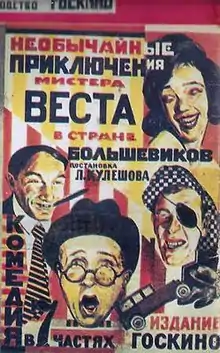The Extraordinary Adventures of Mr. West in the Land of the Bolsheviks
The Extraordinary Adventures of Mr. West in the Land of the Bolsheviks (Russian: Необычайные приключения мистера Веста в стране Большевиков, romanized: Neobychainye priklyucheniya mistera Vesta v strane bolshevikov) is a 1924 comedy film by Soviet director Lev Kuleshov.[1] It is notable as the first Soviet film that explicitly challenges American supposed "stereotypes" about Soviet Russia.[2] The American characters are depicted sympathetically, and the film itself was a reflection of Kuleshov's general love for American cinema and culture.[3]
| The Extraordinary Adventures of Mr. West in the Land of the Bolsheviks | |
|---|---|
 Film poster | |
| Directed by | Lev Kuleshov |
| Written by | |
| Starring | |
| Cinematography | Aleksandr Levitsky |
| Edited by | Aleksandr Levitsky |
| Music by | Benedict Mason (1980s re-release) |
Release date | 27 April 1924 |
Running time | 94 min. |
| Country | Soviet Union |
| Languages | |
Plot
A broad satire of what the director claims are American misconceptions of the Soviet Union, the film centers on the misadventures of the naive Harold Lloyd-esque John West (Porfiri Podobed), a YMCA president from the Cleveland suburb of Brecksville, Ohio. West is planning a trip to the newly founded USSR to spread the idea of the YMCA. However, his wife, Madge, is worried for him, especially after receiving popular American magazines from New York that depict Russia as being full of "savage" Bolsheviks who wear primitive rags and fur for clothing. For protection, West takes along his loyal cowboy sidekick Jeddy (Boris Barnet) on the trip.
However, on arriving in Moscow, his briefcase is stolen, he gets separated from Jeddy and he falls into the hands of a group of thieves, including a run-down countess (Aleksandra Khokhlova), who masquerade as counter-revolutionaries. The thieves play on West's fears and engineer his abduction by crooks dressed up as caricature Bolshevik "barbarians." The thieves then "rescue" West from the clutches of these fictional Bolsheviks, extorting thousands of dollars from him along the way.
In the end, it is the real Bolshevik police who rescue West. Meanwhile, Jeddy has hooked up with Ellie, an American girl residing in the Soviet capital. West then takes a sightseeing tour of NEP-era Moscow, where he sees that the Soviet government did not destroy all cultural landmarks, such as Moscow State University and the Bolshoi Theater, as the thieves suggested. The film culminates in Mr. West watching a military parade with the policeman and concluding that the American view of the Soviet Union is wrong. He telegraphs Madge, instructing her to hang a portrait of Lenin in his study.
Credited cast
- Porfiri Podobed - Mr. John West
- Boris Barnet - Cowboy Jeddy
- Aleksandra Khokhlova - The 'Countess'
- Vsevolod Pudovkin - Zhban
- Sergey Komarov - The One-Eyed Man
- Leonid Obolensky - The Dandy
- Vera Lopatina - Ellie, the American girl
- G. Kharlampiev - Senka Svishch
- Pyotr Galadzhev - Crook
Trivia
The Cathedral of Christ the Saviour in Moscow, which was later destroyed under Stalin in 1931, appears in the film.[3]
References
- Jay Leyda (1960). Kino: A History of the Russian and Soviet Film. George Allen & Unwin. pp. 171–173.
- University of Pittsburgh (2003). "RusFilm 2003". Retrieved 1 November 2008.
- Zorkaya, Neya Markovna [in Russian] (1989). The Illustrated History of the Soviet Cinema. New York: Hippocrene Books. pp. 50–52. ISBN 978-0870525605 – via Internet Archive.